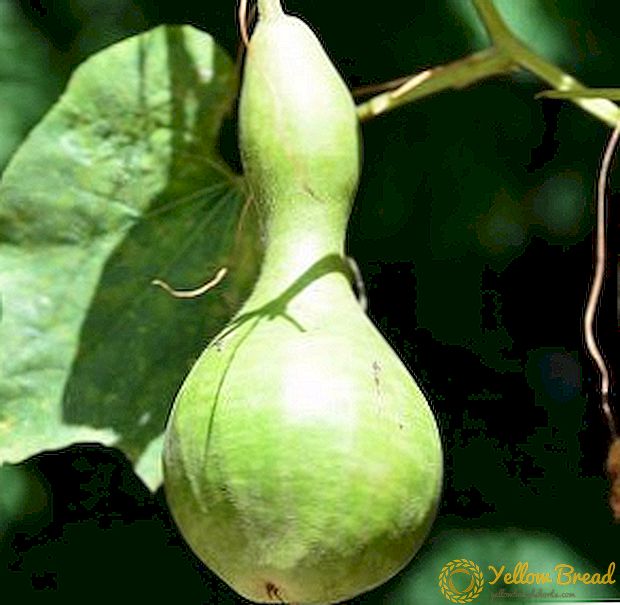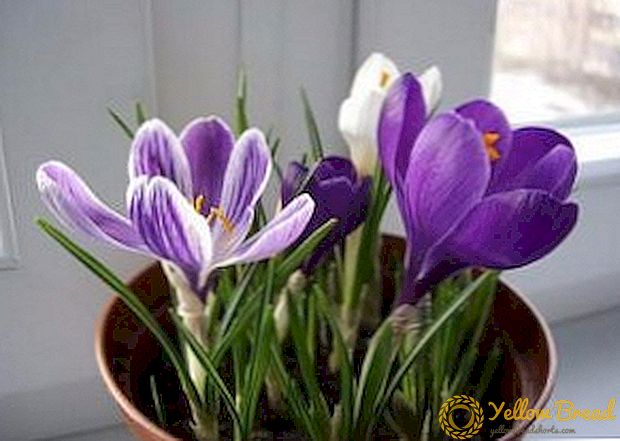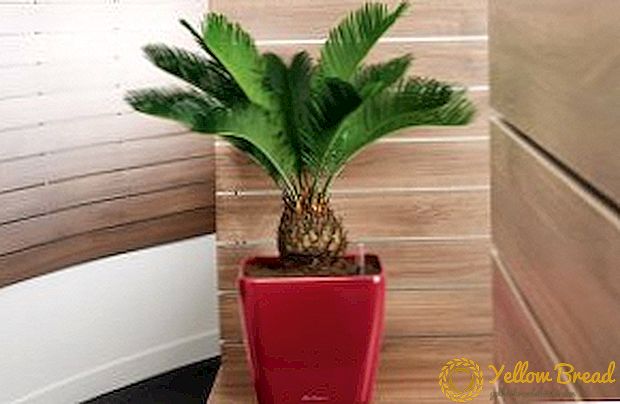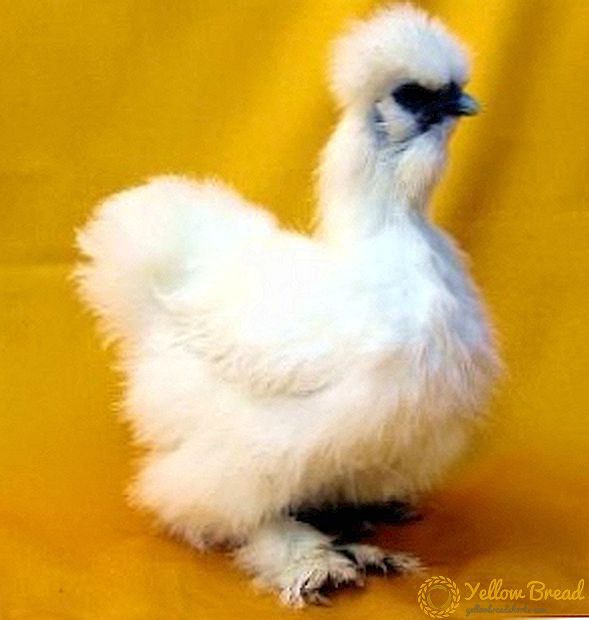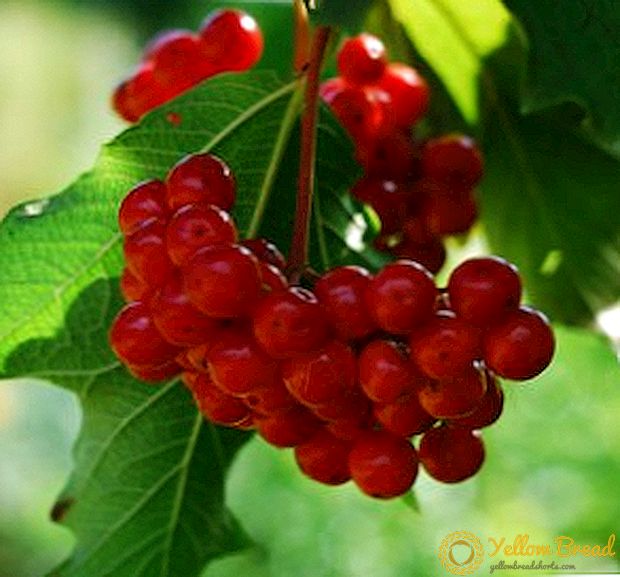 Choosing a certain sort of apple for growing in my garden, I want it to have a luxurious look, tasty fruits and, regardless of weather conditions, always produce a stable crop. Apple tree "Bashkir beauty" has proven itself in all these qualities - a description of the variety with photos, as well as features of planting and cultivation can be found in this article.
Choosing a certain sort of apple for growing in my garden, I want it to have a luxurious look, tasty fruits and, regardless of weather conditions, always produce a stable crop. Apple tree "Bashkir beauty" has proven itself in all these qualities - a description of the variety with photos, as well as features of planting and cultivation can be found in this article.
- History of the variety
- Biological features
- Tree description
- Fruit Description
- Pollination
- Gestation period
- Yield
- Transportability
- Winter hardiness
- Disease and Pest Resistance
- Application
- Planting apple seedlings
- Optimal timing
- Location selection
- Stepwise landing process
- Seasonal care features
- Soil care
- Fertilization
- Disease and pest prevention
- Pruning
- Preparing for the winter
History of the variety
"Bashkir Beauty" - an early winter frost-resistant variety, which was bred by national breeders, its original name is unknown. It was first described in 1928 and registered as a cultivated fruit plant by an employee of the experimental-pomological station Strelayev, and it was from him that it received the name "Bashkir Beauty".

In 1886 in Russia for the first time carried out an industrial landing of the "Bashkir Beauty". The first landing was made on the territory of the present Bashkir Scientific Research Institute of CX, and earlier this land was headed by the merchant Gribushin. In our time, "Bashkir beauty" has earned fame among private gardeners and among industrialists and is grown not only in Bashkortostan, but also practically throughout the whole territory of Russia.
Biological features
Wood is valued for its appearance, its yield, and its durability. It fascinates with its wonderful flowering and beautiful rosy fruits.
Tree description
Tree refers to medium strong. Crohn has a rounded shape at a young age, and after it enters fruiting it becomes a broad-pyramidal, slightly sprawling, foliage of medium thickening. The branches tightly spliced with the trunk, depart at an angle of 90 °. On the main branches and on the trunk, the bark is smooth, brown-green. The shoots have a rounded shape, the size is average, straight, brownish-brown color, shaggy.
The variety among young planting trees is distinguished by the fact that the tops of the shoots are white and pronounced pubescencethan the tree immediately attracts attention.

The leaves are large, oval-shaped, green, tops with short pointed. The edges of the foliage have serrate-like serration. The upper side of the leaf plate is smooth, flat, streaked, slightly wrinkled, and the back side is very fleecy.
Flowering on average occurs in the second half of May. Large flowers of white and pink color, collected in medium-sized inflorescences, emit a pleasant aroma.
Fruit Description
Fruits have a mass of up to 100 g, but if you regularly feed the plant, you can gain up to 140 g. Apples are wide-conical, regular shape, one-dimensional. The skin is smooth, glossy, thick and rough. Ripe apples have a green color with a reddish blush, and eventually brighten slightly, acquiring a whitish color with stripes of blush.
Seeds are light brown, large, broadly ovate. Pulp of average density, white color, fine-grained structure. Apples are very juicy, sweet and sour, sometimes with a pleasant bitterness. The fruits have an attractive appearance and have in composition:
- sugar - 12.4%;
- ascorbic acid - 11.3 mg per 100 g;
- dry substances - 16.3%;
- organic acids - 0.57%.

Pollination
"Bashkir Beauty" refers to the samobzheplodnyhThe apple varieties such as Antonovka, Buzovyazovskoye, Titovka Seedling are good pollinators for her.
Gestation period
Although the variety belongs to early-winter, with good and warm conditions, fruits can be removed as early as August. If summer was cold, then apples ripen in September.
Yield
Fruiting occurs at 4-6 year after disembarkation. From one tree you can collect up to 80 kg of fruit, indicating a high yield.
Transportability
Consumer maturity of apples comes a week after harvest. Good ripened fruit while creating optimal conditions can be stored for up to 130 days. "Bashkir beauty" is particularly fond of growing industrialists, because it lasts a long time and is almost not damaged during transportation.

Winter hardiness
Trees quickly adapt to the harsh climate, in cases of freezing they are quickly restored.
Disease and Pest Resistance
Sort medium stable to the defeat of various diseases and pests, which, perhaps, is its only drawback. A common disease is considered to be the black leg, and among the pests, the apple tree is the most susceptible to the attacks of the moth.
Application
The variety is considered universal, since the fruit can be used both fresh, and canned, dried and use other processing methods.
Planting apple seedlings
"Bashkir beauty" - the apple tree is not picky, the correct methods of planting and care will only improve the quality of the crop.

For full growth and good rooting of a plant, it is necessary to follow the rules of planting an apple tree and determine the most suitable place. The timing of the landing is also important.
Optimal timing
In the southern areas it is better to plant the apple in the autumn. Planting is carried out in early October, for the autumn-winter period, the sapling will “get comfortable” and take root well, and in spring it will be able to fully gain strength for good growth.In areas with more severe climatic conditions, it is better to plant in the spring in order for the tree to take root and grow strong before the onset of a cold winter.
Location selection
Although the grade and considered unpretentious, but it is very sensitive to adverse conditions. It is better not to plant an apple tree on the north side of the plot, because cold northern winds will damage it during periods of flowering and the onset of fruiting.
The apple tree "Bashkir Beauty", according to gardeners, grows poorly and bears fruit on wet soils and areas where ground water is close to it. Light neutral soil and gray loamy forest soil, as well as black soil, are ideal.
Stepwise landing process
The landing pattern is observed, as for other types of apple trees - 4 by 4.
The size of the planting pit is prepared depending on the volume of the root system and the age of the seedling, but must be at least 0.6 m deep and 0.8 m in diameter. At the bottom of the pit you need to drive a strong stake, which will serve as a support for the young tree.
Seedling needs primary feeding: Mix a layer of fertile upper ground with 60 g of superphosphate, 20 kg of humus and 50 g of potassium sulfate. Before planting, inspect the roots and remove rotted or damaged fragments.
The root neck should be 5 cm above the ground level. The earth around the trunk must be compacted, but in no case be compacted.
A cushion of soil is created around the seedling in order to hold irrigation water. After planting, the tree is watered generously, and the soil is mulched with humus, small bark of trees with the addition of ash.
The seedling should be fixed to the cola, but in any case not to stretch it, so as not to cause harm with the thickening and growth of the trunk.
Seasonal care features
Good fruit formation directly depends on competent care of an apple tree. Observance of the correct regime of feeding, watering and other types of processing ensure the healthy development of the tree.
Soil care
In the near-circle wheel, it is necessary to periodically loosen the soil and clean weeds. Loosening the soil around the young seedling should be done to a depth of no more than 12 cm in order not to damage the roots. The first two years after planting it is obligatory to perform weeding and removal of vegetation around the tree before irrigation.
Composting or humus mulching serves young plants as a good fertilizer, and it can be used to avoid the need for loosening and weeding. Also, mulching helps retain moisture and improves aeration.
Sodding is an excellent way to increase the productivity of horticultural crops due to the improvement of the soil layer. Especially in the first time after planting "Bashkir Beauty" it is worth paying much attention to watering, they should be abundant and frequent with adjustments for weather conditions.

Fertilization
Starting feeding during landing is depleted in the second year. Non-fruitful young cultures top dressing make three times during the growing season:
- Spring is made with a solution of urea - 10 liters of water 2 tablespoons of urea; it is brought under a root.
- Summer is made to improve the growth of shoots and increase the green mass, suitable complex fertilizers - sodium humate, "Ideal".
- Autumn fertilizing plants help prepare for the winter - they make potash-phosphate fertilizers.
Disease and pest prevention
The best prevention from diseases and pests is the right care - a strong well-groomed culture is less amenable to adversity than a weakened one. Add all fertilizers in time and also remove old and affected shoots in time.
An important role is played by the quality of the acquired seedling, so it is better to buy a tree from reliable vendors and in specialized stores. The seedling should be adapted in the area of your residence.
In the fight and prevention of pests worth remembering about the birds, they are the best defenders against insects. If you notice that the tree is already sick, then the most effective means is the use of chemicals.
Pruning
During primary pruning, 2-3 branches are left on the shtamba, which are directed in different directions, but not inward.The center conductor should be 1 / 3l longer than the others, and this principle is respected with all subsequent trimming.
Trimming is done for such purposes:
- bummer prevention;
- rejuvenation of a tree and increase of fruit formation;
- reduced thickening, which reduces the risk of disease.
Preparing for the winter
After harvesting (August - September), the last abundant watering is done so that the tissues of the apple trees are saturated with moisture and do not experience a deficit in it. Before carrying out the last feeding, the stem should be freed from mulch.
To protect against rodents, the trunk is wrapped with roofing felt, tar or other available materials. Harness is carried out with the onset of cold weather (late autumn), if it is too early, you can extend the growing season, which is dangerous for wintering.
After leaf fall, processing of vitriol or urea can be performed in order to prevent diseases and pests. Fallen leaves must be destroyed. An earthing up of the stalk zone is performed to protect the roots, especially young plants.
"Bashkir beauty" is not afraid of evil and harsh winters, needs special protection only in the first years after planting. With the right landing and care, it will go well in growth, and already in the fourth year you will be able to enjoy the first harvest.

